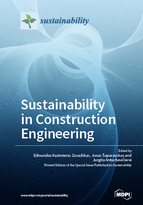Sustainability in Construction Engineering
A special issue of Sustainability (ISSN 2071-1050).
Deadline for manuscript submissions: closed (30 April 2018) | Viewed by 237893
Special Issue Editors
Interests: operations research; optimization and decision analysis; multicriteria decision making; multiattribute decision making (MADM); decision support systems; civil engineering; energy; sustainable development; fuzzy sets theory; fuzzy multicriteria decision making; sustainability; management; game theory and economical computing knowledge management
Special Issues, Collections and Topics in MDPI journals
Interests: energy efficiency of buildings; sustainable construction; multiple criteria decision making; building construction technology and organisation
Interests: multi-criteria decision-making (MCDM); multiattribute decision making (MADM); operations research; decision support systems; multiple-criteria optimization in construction technology and management; decision making under uncertainty; fuzzy sets theory; civil engineering; sustainable development; sustainable construction; investments; knowledge management
Special Issues, Collections and Topics in MDPI journals
Special Issue Information
Dear Colleagues,
The concept of sustainability expands to all areas of human activity, including construction engineering. Construction engineering is a complex discipline that involves the designing, planning, construction and management of infrastructures. The application of elements of sustainability in any construction (engineering) activity increases the overall level of construction sustainability.
Articles are welcome on this issue, where sustainable solutions in construction engineering that bring economic, social and environmental benefits are offered through a variety of methodologies and tools (e.g. information technologies, life-cycle analysis, multiple criteria decision making methods). Articles that propose new methodologies dealing with construction sustainability issues are also welcome.
Prof. Dr. Edmundas Kazimieras Zavadskas
Assoc. Prof. Dr. Jonas Šaparauskas
Prof. Dr. Jurgita Antuchevičienė
Guest Editors
Manuscript Submission Information
Manuscripts should be submitted online at www.mdpi.com by registering and logging in to this website. Once you are registered, click here to go to the submission form. Manuscripts can be submitted until the deadline. All submissions that pass pre-check are peer-reviewed. Accepted papers will be published continuously in the journal (as soon as accepted) and will be listed together on the special issue website. Research articles, review articles as well as short communications are invited. For planned papers, a title and short abstract (about 100 words) can be sent to the Editorial Office for announcement on this website.
Submitted manuscripts should not have been published previously, nor be under consideration for publication elsewhere (except conference proceedings papers). All manuscripts are thoroughly refereed through a single-blind peer-review process. A guide for authors and other relevant information for submission of manuscripts is available on the Instructions for Authors page. Sustainability is an international peer-reviewed open access semimonthly journal published by MDPI.
Please visit the Instructions for Authors page before submitting a manuscript. The Article Processing Charge (APC) for publication in this open access journal is 2400 CHF (Swiss Francs). Submitted papers should be well formatted and use good English. Authors may use MDPI's English editing service prior to publication or during author revisions.
Keywords
- Building’s site selection
- Building’s design
- Building materials and structures
- Construction economics
- Supply chain management
- Construction procurement
- Contracting
- Construction management
- Construction processes
- Building’s maintenance
- Information technologies
- Building life-cycle analysis
- Multiple criteria decision making








